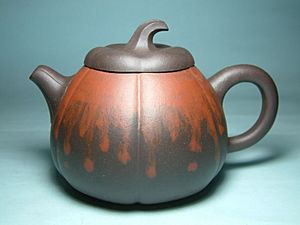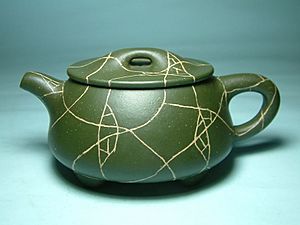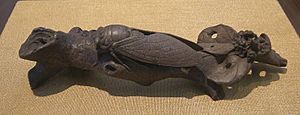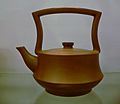Yixing ware facts for kids
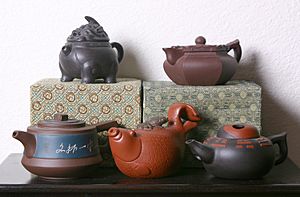
Yixing clay is a special type of clay found in China. It comes from the area near the city of Yixing in Jiangsu Province. People have used this clay to make beautiful Chinese pottery since the Song Dynasty (960–1279). That's when Yixing clay was first dug up near China's Lake Tai.
From the 1600s onwards, items made from Yixing clay were often sent to Europe. The finished pottery, called stoneware, is usually red or brown. It is used for teaware and other small things. Yixing clay is also known as zisha ware. These items are usually left without a shiny coating. The clay is very sticky and can be shaped in many ways. It can be rolled into coils, flattened into slabs, or poured into molds. The most famous things made from Yixing clay are Yixing clay teapots, tea pets, and other tea items.
Contents
Types of Yixing Clay
Zisha clay comes in three main colors: purple, red, and beige. Each color comes from a slightly different type of clay.
- Purple Clay (Zi Ni): This clay makes pottery that is purple-red-brown. It's often called "purple sand" or "purple clay."
- Red Clay (Zhu Ni): This clay makes reddish-brown pottery. It has a lot of iron in it. The name "zhu ni" means "cinnabar sand" because it can be a bright red color, like the mineral cinnabar. This type of clay is now very rare because so many people want Yixing pottery. Don't mix up zhu ni with hong ni, which is another type of red clay.
- Beige Clay (Duan Ni): Pottery made with duan ni is beige or light white/green. Duan ni is actually a mix of different clays. Pottery made with green clay (Lv ni) also looks beige.
What's in Yixing Clay?
Yixing clay is a mix of different minerals. These include kaolin, quartz, and mica. It also has a lot of iron oxide, which gives it its color. This special clay is mostly dug up from mountains called Huanglongshan and Zhaozhuangshan. It feels a bit sandy.
Preparing the clay used to be a big secret and took a long time. The clay is usually heated in a special oven called a kiln. The temperature is very hot, between 1100 and 1200 degrees Celsius (about 2000 to 2200 degrees Fahrenheit).
How Yixing Clay is Made
The raw materials for Yixing clay are found deep underground. They are often buried under heavy layers of rock. When the clay is dug up, it's usually in layers with other types of clay. A layer of Yixing zisha clay can be from a few decimeters (about a foot) to a meter (about three feet) thick.
Yixing clays are made of fine silt that contains iron. Their main minerals are mica, kaolinite, and different amounts of quartz and iron ores.
Here's how raw Yixing clay is prepared:
- First, the clay is taken from the ground.
- Then, it's dried in the sun in open areas.
- After drying, the clay pieces are crushed into very fine powder.
- This powder is then sifted to get the finest clay particles.
- Next, the fine clay powder is mixed with water in a large mixer to make a thick paste.
- This paste is piled into heaps and then processed to remove air bubbles and some moisture.
- The amount and quality of water in the clay are very important. They decide how good the finished pottery will be.
- After all this, the clay is ready to be used by artists.
Artists can change the look of Yixing products. They can add different metal oxides to the clay to change its color or texture. They can also control the temperature in the kiln and the air inside it. This helps them create different looks for the finished pottery.
What Yixing Clay is Used For
Yixing teawares are highly valued. This is because their surfaces are not glazed, so they can soak up tiny bits of the tea. Over time, this makes the tea taste even better and more complex. Because of this, Yixing teawares should never be washed with soap. You should only wash them with water.
Tea lovers often suggest using each Yixing teapot for only one type of tea. For example, one pot for green tea, another for oolong, and so on. Some even use a pot for just one specific kind of tea.
Early Yixing teapots were made for people to use when traveling. So, they had a simple, classic look during the Ming dynasty. Many tea fans still have a travel teapot. These are usually less expensive and easy to carry.
It wasn't until the mid-Qing dynasty (1700s) that people started using these pots more at home. That's when artists began to make them in many different shapes and sizes. They created many unique designs. Artists also decorated the teapots with poems, beautiful writing, paintings, and special stamps.
Yixing Clay's Influence in Europe
In the late 1600s, Yixing teapots were brought to Europe along with Chinese tea. Europeans had never seen this kind of material before. It inspired them to try and copy it. In 1678, a company in Delftware, Netherlands, said they were making "red teapots." We don't have any of those left today.
However, some red stoneware made by other Dutch potters around 1700 still exists. These pots copied the Yixing style very closely. Johann Friedrich Böttger, who was famous for creating European porcelain, learned from these potters. He developed his own "Böttger ware," which was a dark red stoneware. It was first sold in 1710. Other potters also made and copied it until about 1740. This was a very important step in how porcelain developed in Europe.
Images for kids


